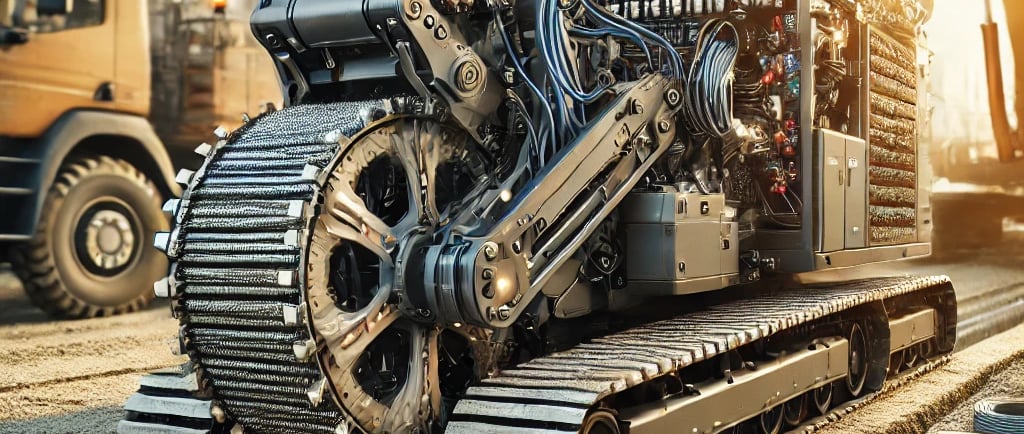Burying power lines: a strategic and technological revolution to watch
Find out how burying power lines is transforming energy networks in Europe. Innovations, key players and strategic opportunities: stay ahead of the curve with comprehensive analysis and market insights
VEILLE MARKETINGMARKETINGRSE
LYDIE GOYENETCHE
1/7/20254 min read


Market analysis: Burying power lines, or how to hide the essential to reveal the future
Let's bury the past to illuminate the future
Burying power lines is not just a matter of wires and trenches, it is a silent revolution. With nearly 47% of the French network already underground according to Enedis, France is leading the way. Spain, with about 30% of its lines underground, is moving at its own pace by focusing on strategic innovations. In a Europe where the energy transition imposes ambitious objectives, these initiatives are not just a choice, but a necessity.
The economic and technical challenges remain high: how to reduce costs, which vary between €80,000 and €120,000 per kilometre (Source: Ministry of Ecological Transition), while meeting the growing expectations of local authorities, network operators and citizens?
The Hidden Challenges of Buried Lines
Dizzying costs
Burying a kilometre of medium-voltage line represents a significant investment. In France, Enedis spent €1.3 billion in 2022 to modernise its network, a large part of which was dedicated to landfilling. The manager aims to reach a rate of 70% in sensitive areas by 2030.
State-of-the-art tools
Companies such as the Marais Group, a subsidiary of Tesmec, are revolutionizing the sector with their automated slicers. These machines reduce installation times and the environmental impact of the work, allowing up to 1 km per day to be processed in optimal conditions.
A controlled environmental impact
Landfilling limits the risks associated with bad weather and protects networks against storms, which caused €1.6 billion in damage in France between 2000 and 2020 according to the Ministry of Ecological Transition (Source: Ministry of Ecological Transition). It also helps preserve biodiversity by eliminating pylons that fragment natural habitats.
Europe: harmonisation as a leitmotif
The European Union imposes strict standards through CENELEC (Source: CENELEC), guaranteeing the security and interoperability of infrastructures. At the same time, flagship projects illustrate the cross-border dynamics: the France-Spain interconnection via the HVDC Baixas-Santa Llogaia link, managed by RTE and Red Eléctrica, is an emblematic example (Source: RTE). This 64.5 km line, mostly underground, carries up to 2,000 MW of electricity, reducing energy losses by 30% compared to conventional lines.
Spain is also investing heavily in its infrastructure: Red Eléctrica has planned a budget of €4.4 billion between 2021 and 2026, part of which is for underground and modernisation of the network (Source: Red Eléctrica).
Collaborating with Enedis: an opportunity for innovative suppliers
Becoming an Enedis supplier opens the way to strategic collaborations. Companies must obtain ministerial authorisation, join forces with a Balance Responsible Party and sign a DSO-Supplier contract to operate on the Enedis network (Source: Enedis Suppliers). Payment terms, generally 60 days, offer a certain financial predictability, and Enedis is committed to respecting these deadlines at 95%, testifying to efficient management.
SMEs can position themselves in this market through subcontracting (civil engineering, mapping, impact studies) or by responding to calls for tenders from Enedis and European players.
Participating in trade shows: a strategic lever
To make yourself known and build strategic partnerships, participation in trade shows is essential. Here is a selection of the key events in Europe for players in the power line burying sector:
Elektrotechnik (Dortmund, Germany): February 12 to 14, 2025. Specialized exhibition for electrical engineering and automation.
Enex (Kielce, Poland): February 18 to 19, 2025. International Exhibition of Energy Production and Distribution.
Amper (Brno, Czech Republic): March 18 to 21, 2025. Exhibition of electrical engineering, electronics and automation.
BePositive (Lyon, France ): March 25 to 27, 2025. Exhibition dedicated to the energy and ecological transition.
Light + Building (Frankfurt, Germany): March 13 to 18, 2026. Leading trade fair for lighting and building services technologies.
These events provide an opportunity to showcase innovations, meet decision-makers and understand market trends. They are a key opportunity for any company looking to enter the sector.
In five years: a revolution at the end of the trenches
Growth prospects
In France, the France Recovery Plan allocates €100 million to strengthen electricity networks, particularly in rural areas (Source: France Relance). In Spain, similar programmes encourage the integration of innovative technologies such as the self-repairing cables developed by Prysmian Group (Source: Prysmian Group).
Advanced monitoring systems, such as those offered by Schneider Electric, allow for real-time monitoring of the condition of infrastructure. These solutions reduce maintenance costs by 20 to 30% while extending the life of installations (Source: Schneider Electric).
Analyse SWOT :
Strengths: Infrastructure modernization, weather resilience, technological innovations.
Weaknesses: High costs, administrative delays, complex coordination between actors.
Opportunities: European energy transition programmes, emergence of new technologies.
Threats: Resistance of local authorities, budgetary constraints, implementation deadlines.
What you can't see underground: a well-crafted strategy
The success of landfill projects depends on appropriate financing and effective communication. Enedis and RTE, the main French players, are working closely with local authorities to prioritise areas at risk. In Spain, Red Eléctrica is deploying similar strategies, targeting regions exposed to climatic hazards.
Innovations such as GE Grid Solutions' intelligent systems, which can detect anomalies in real time, ensure proactive grid management and resource optimization (Source: GE Grid Solutions).
Conclusion: a buried opportunity that needs to emerge
Burying power lines is much more than a technical challenge, it is a strategic opportunity to modernize infrastructure, improve energy resilience and meet societal expectations. With a clear vision and committed players such as Enedis, Red Eléctrica and Prysmian Group, this sector can transform challenges into levers for sustainable growth.
It's a call to all visionary companies: seize this chance to innovate and build a future where energy flows safely and discreetly, hidden underground but at the heart of our daily lives.


EUSKAL CONSEIL
0033782505766
euskalconseil@gmail.com
This website uses only Plausible Analytics, a privacy-friendly web analytics tool.
No cookies are used, and no personal data is collected from visitors.
The system is fully compliant with the General Data Protection Regulation (GDPR), the ePrivacy Directive, and CNIL recommendations.
You can read more about Plausible’s data policy here: https://plausible.io/data-policy